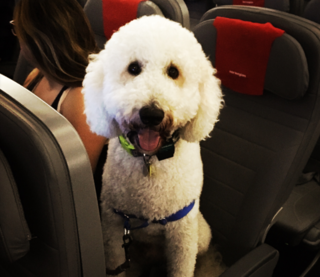Health
Here's Why There Will Be a Lot Fewer Animals on Planes
New rules about flying with emotional support animals have welfare implications.
Posted December 20, 2018

In a controversial article in Slate titled Pet's Don't Want To Be Emotional Support Animals, Christine Calder argued it can be unethical to require other creatures to provide us with psychological support, particularly on airplanes. I am sure airline executives will be on board with her line of thinking as the exponential increase in the number of on aircraft in recent years has translated into more and more headaches for airlines, crews, and passengers.
The service and support animals I’ve encountered in the air have been well-behaved. But my niece Olivia was justifiably angry when the pilot announced that the plane flying her to Denver was returning to Philadelphia because on an out-of-control emotional support dog. Granted, this incident is the exception and not the rule, but in a recent survey of 5,000 flight attendants, 61% of respondents said they had worked on a flight in which an emotional support animal (ESA) had created a disturbance.
To address the problem, in 2017, the Department of Transportation gathered a high-powered group of disability advocates and airline industry representatives who were charged with revising the Air Carrier Access Act support animal rules. (For an excellent guide to these confusing regulations, see Service and Support Animals Explained by Karin Brulliard of the Washington Post.) This conclave, unfortunately, was a failure. After seven months of back and forth, the panel could not agree on any changes to the regulations.
Because of the government’s inability to establish coherent guidelines regarding service/support animals, individual airlines have started taking matters into their own hands. The result is a mishmash of policies which differ between airlines. And in some cases, these rules conflict with federal regulations. (Alaska Airlines, for example, now only recognizes dogs and cats as emotional support animals.) But whether you like them or not, these changes in policies have major implications for people traveling with “comfort animals.” Take, for example, a series of rules Delta has instituted over the last 12 month (here).
The Devil Is In the Details
Delta’s policy for flying with support animals starts innocuously enough, “Delta welcomes travelers with service or emotional support animals in the aircraft cabin.” But in reality, their new rules make it much more difficult to fly with animals. Here is a breakdown of the most important changes.
- Mental health letters. Delta passengers no longer need to provide the airline with a letter from a physician or therapist to take their emotion support animals (ESAs) on a flight. Instead, their doctor/therapist has to sign a standardized form indicating that the passenger is suffering from a recognized and ongoing mental health disability. Most importantly, the physician/therapist also has to attest that the passenger is “currently under my care.” If enforced, this proviso could lead to the demise of the shady internet sites that offer bogus ESA letters for as little as $29. In fact, one of the biggest providers of fake ESA travel letters now includes a small-print footnote at the bottom of their website which says, Due to recent Policy updates in 2018 some major airlines will require a reasonable accommodation form that our therapist cannot complete…If you are flying with the following airlines we recommend you do not purchase the travel letter: Delta, United, American, Southwest, JetBlue, and Alaska.
- Training. Passengers with ESAs on Delta must now sign a form confirming that the animal has been trained to behave in public. This a major change in the rules as under the Air Carrier Access Act, ESAs do not need to be trained. (However, Delta does not require proof of training. Attendants at the boarding gate have to take the passenger’s word at face value.)
- Species. The training requirement would seem to eliminate emotional support ducks, squirrels, and miniature pigs. But to cover themselves further, a footnote in the Delta policy states, Any animal other than a dog or cat will be evaluated on a case-by-case basis.
- No more Pit Bulls/Mixes. Pit bulls and pit bull mixes are no longer allowed onboard Delta flights. This rule is bound to raise the hackles of the many thousands of pit bull enthusiasts who adamantly oppose any laws or regulations that discriminate between individual breeds of dogs. A potential problem is that even experts are surprisingly poor when it comes to judging “pit bull or not” (here). When I asked a representative from Delta who was going to decide if a dog was a pit bull, he said the gate attendants would take the passenger's word for it. The representative also told me the pit bull ban was developed after an emotional support dog mauled a Delta passenger in Atlanta. Ironically, that dog was a Labrador retriever/pointer mix, not a pit bull.
- Personal liability. The owners flying with their emotional support animals on Delta might want to purchase one of those umbrella liability insurance policies. The reason is that passengers with ESAs must now sign this statement: “I understand that I will be expected to reimburse Delta or its passengers for any loss, damage, or expense resulting from any misbehavior of my animal.” This could amount to a lot of money when, for example, when an unruly support animal causes to plane to turn around mid-flight.
- Minimum age. Delta no longer allows emotional support animals under the age of four months.
-
 Source: Dog by Susan Richey-Schmitz/123RF; Seat by Nerthuz/123RF
Source: Dog by Susan Richey-Schmitz/123RF; Seat by Nerthuz/123RFWhere to Put Support Animals? Delta is clear when it comes to where ESAs belong. If no larger than a human baby, they can sit in their owner’s lap. Otherwise, “they must remain in the owner's personal seat/foot space at all times during the flight while the owner is seated.” So, how much “foot space” does an emotional support animal have on the seven-hour flight from New York to San Francisco? Not much. The typical space under a Delta seat is only 2.6 cubic feet: 11 inches high, 17 inches long, and 20 inches wide. In comparison, the average Golden Retriever is 22 inches high at the shoulder. Indeed, the three most popular dog breeds in the United States (Labs, Goldens, and German Shepherds) will have trouble meeting Delta’s ESA rules because they are too big to fit under a seat. The Delta representative did tell me that passengers have the option of purchasing an extra seat for larger animals. (He admitted that the animal is not allowed to actually sit in the seat, but he said it would give them a bit of additional room to lie down on the flood.)
- Maximum flight length. ESA and psychiatric service animals are now banned from flights longer than 8 hours. From a welfare perspective, this makes sense. At 6’1” inches, I find “economy class” seating on airplanes painful. For a mid-size or large dog, spending hours crammed under one of these seats seems cruel.

While I have focused on recent changes in Delta Airlines’ policies regarding service/support animals, other airlines are following suit, though there are some differences. For example, Spirit Airlines now only recognizes psychologists, psychiatrists, and clinical social workers as “mental health professionals.” American Airlines validate requests for an emotional support animal by actually contacting “your mental health professional.” And Alaska Airlines only considers dogs and cats as emotional support animals.
Good News for Emotional Support Animals?
Unfortunately, the proliferation of rules by individual air carriers will make it much more difficult for people with legitimate psychiatric problems to travel with comfort animals. The good news is that there are positive animal welfare consequences to fewer emotional support animals in the air. Unlike service animals which are highly trained to function in public places, the average ESA is a personal pet who is likely to be stressed, if not terrified, by being surrounded by strangers and crammed into a noisy space smaller than a suitcase for hours at a time (here).
I think Christine Calder was right when she wrote in Slate, “Maybe the solution to the long-standing debate over animals on planes is focusing on what’s best for our pets.”
References
Calder, C. (November, 2018). Pets don't want to be emotional support animals. Slate.
Olson, K. R., Levy, J. K., Norby, B., Crandall, M. M., Broadhurst, J. E., Jacks, S., & Zimmerman, M. S. (2015). Inconsistent identification of pit bull-type dogs by shelter staff. The Veterinary Journal, 206(2), 197-202.
Bergeron, R., Scott, S. L., Émond, J. P., Mercier, F., Cook, N. J., & Schaefer, A. L. (2002). Physiology and behavior of dogs during air transport. Canadian Journal of Veterinary Research,66(3), 211.


